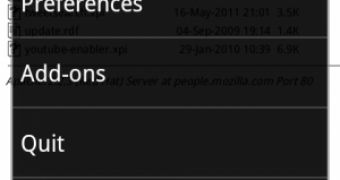Non-profit organization Mozilla is working on improving the experience that users receive from its Firefox for Android browser, and the company has announced plans to come up with a new flavor of the app, one that would offer a Native UI, and not the XUL-based UI we're all accustomed with. Those who might have missed our previous articles on the Native Firefox for Android are certainly aware of the fact that it should provide far better loading times, and that browsing should be faster than before.
This is possible due to the lack of the XUL-based UI, which enables the user to interact with the browser's interface while the Gecko engine would load in the background.
However, the features that Firefox for Android already comes with, and which users certainly grew to love, will still be there, including support for add-ons, as Mark Finkle explains in a recent blog post.
Since add-ons are one of the most important features in Firefox and Firefox for Android, the move to a Native UI on the mobile browser was bound to keep the feature unaltered.
Even so, there are some aspects that add-on developers need to be taking into consideration:
- The add-ons system is the same one used in other Mozilla applications. We did not invent a new add-on system. - There is no visible XUL in the UI, so using overlays to try to add or change UI is useless. - There is a simple NativeWindow object that allows you to manipulate parts of the native Android UI. - Services like nsIPromptService and nsIAlertsService are implemented to use native Android UI. - Since overlays are useless for UI and JavaScript APIs are available for native UI, you should seriously consider just making a restartless add-on. Mozilla has come up with a helper object called NativeWindow that should offer add-on developers the possibility to manipulate the native Android UI, and is even considering the release of other APIs as well.
With the new API, devs will have access to Android Menu, Doorhanger Notifications, Context Menus (in web content) and Android popup toast alerts.
The basic API can be found on Mark Finkle’s Weblog here.

 14 DAY TRIAL //
14 DAY TRIAL //